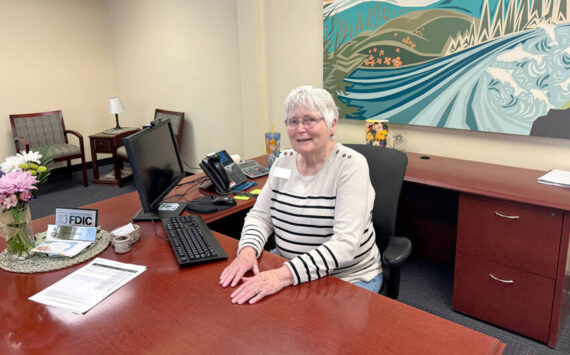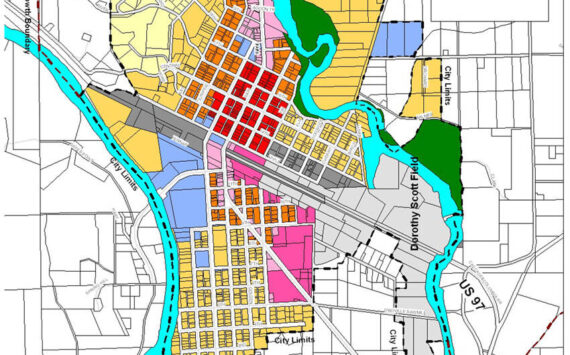City pool discussed again
TONASKET – Two Washington Department of Transportation officials visited the Tonasket City Council during its Tuesday, April 8, meeting. While much of the talk concerned controversial topics such as the oft-discussed Heavy Haul Corridor proposal and the US-97 chip seal project that is getting underway. Local Programs Engineer Paul Mahre and Project Engineer Kirk Berg seemed to have more commonalities than differences with the council and mayor, who have been critical of work and plans for US-97 through town that they feel don’t address the city’s actual needs.
Berg said that the condition of US-97 through town did merit more extensive work than the chip seal currently getting underway, but that a statewide shortage of transportation funding meant that a chip seal was all that could be accomplished.
“We’re aware of your concerns through town,” Berg said. “I commiserate and understand, but that doesn’t get anything done. The way the economy and transportation budget are, we’re looking for money anywhere we can. We’ll continue to do so. Your words and sharing haven’t fallen on dead ears, but they haven’t come up with any money.”
A frustrated Mayor Patrick Plumb, a couple of months ago, sent a group email to every DOT official he could find on the agency’s “contact us” page on its website, hoping to get a response.
“To some extent, you’re getting the word out there are serious issues in Tonasket and you’re making that well known with the people making decisions,” Mahre said. “I don’t know if it will help with (getting project) grants or not.”
The possibility of a Heavy Haul Corridor being extended from Oroville to Pateros – through the middle of Tonasket – was discussed, and though the idea has been backed by the Okanogan County Commissioners and was introduced in a bill to the state legislature, the city has been frustrated by a lack of communication over its potential effects on Tonasket.
“I have no problem with DOT,” Plumb said. “You’ve been very helpful… The bill presented to the legislature says they would follow DOT guidelines. The funny thing was that the DOT said that the mile that goes through Tonasket needs to be totally redone (at an estimated cost of $5 million).”
There was also an estimate of $55 million of upgrades needed on the full stretch of highway to Pateros.
“That a parametric estimate,” Berg said. “And all of a sudden there was this bill going forward. We didn’t have time to do an in depth analysis.”
“Just reiterate, you never said zero?” asked Plumb, referring to earlier statements by the county commissioners that the Heavy Haul Corridor designation wouldn’t cost money. “It just magically came out and I was notified it was zero.”
Berg added that when the Heavy Haul Corridor was put in place through Oroville several years ago, much of that money came from a one-time funding source designed to enhance infrastructure in border towns in preparation for the Vancouver Winter Olympics in 2010.
“I don’t know where Heavy Haul is going from here, Berg said. “Basically the department supports Heavy Haul from an economic development standpoint… We’re still looking at the issues and we can’t define that until we know what kind of loads we’re talking about, who is hauling them.”
“It would economically develop one or two people’s pockets, that’s for sure,” said council member Jean Ramsey.
“Money not withstanding,” Plumb said, “would there would be more traffic if that was allowed, or less traffic if that was allowed?”
Mahre, emphasizing that he was not a traffic expert, said, “More. But that is just my opinion.”
“In order for DOT to analyze the effects, we need a lot more information than what we’ve got,” Berg added. “Also realize it wasn’t the DOT that took this to the legislature. When it does get to your legislative body, they are the ones that make the decisions. They just use the information we provide.”
Council member Scott Olson also brought up the loss of the wheelchair ramp at the corner of Third Street and Whitcomb, that has cut off easy sidewalk access in the downtown core. The ramp was removed during a street project last summer due to bureaucratic red tape involving grant funds used for the project.
“When we used (Transportation Improvement Board) funding for that project we had to take it out,” Plumb said. “The wheelchair ramp has to go in (DOT’s) right of way (on US-97) and not ours (on Fourth). We couldn’t move the ramp because it wouldn’t be up to code. We’ve all gotten multiple complaints.”
“It was my understanding when we were doing the grant, that the state was coning through to fix the intersections,” Olson said. “It was part of the larger project that isn’t happening. Instead we ended up taking out a ramp (that already existed) and left people without access at one of our main intersections.”
Mahre said that he and Berg would do a visual check of the intersection following the meeting and added that some specific grants could be applied for that would allow for the ramp to be replaced.
Mahre and Berg added that, despite the difficulty of the issues discussed, they appreciated the tone of the meeting.
“Kirk didn’t even get anything thrown at him,” Mahre said.
Pool
Karen Stangland, representing the community group that has been meeting to work on plans to replace the city swimming pool, was on hand to discuss a number of points regarding the funding of the pool.
Chief among them was whether or not it would be necessary to get a recreation district formed in order to secure funding for annual maintenance of the pool once it’s built.
Plumb noted that when he met with the Okanogan County Commissioners several weeks ago, there wasn’t much enthusiasm for putting a rec district on the ballot.
“The county is saying that they don’t feel they want to give another tax district a shot,” Plumb said. “They said they should let the people decide. I asked how we can do that if they can’t vote on it.”
“You do have to have the commissioners’ approval (to get it on the ballot),” said City Planner Kurt Danison, who along with Olson had also attended that meeting with the commissioners. “It goes on the ballot and someone has to pay for that vote. It’s not cheap. If you look at the statute you have to have a petition that would need to be approved to get it on there…So we might want to talk to the folks in the Methow.”
Stangland asked if the city had the funds to maintain the pool without forming a tax district.
Noting that the council had enough of a problem covering its current budget without the additional $40,000 or so it would cost to maintain the pool, Plumb said that the commissioners had suggested covering that expense with user fees.
“That would mean charging a five year old $20 to use it for a day,” Plumb said. “And no one is going to do that.”
Some comparisons were made with the construction of the U.S. Armed Forces Legacy Park; however, that project, which took nine years to pull together, was able to utilize about $450,000 in donated labor and had a number of major financial donors.
Danison pointed out that, regardless of funding source, the pool would be a city project and would be subject to far more regulation.
“It’s not fair to compare to the Legacy, anyway,” Ramsey said. “It could be done in small, incremental pieces. The pool will have to be done all at once.”
Stangland brought it back to the maintenance issue.
“We haven’t debated it much, but we need help,” Plumb said. “Whether that be someone being the ultimate sugar daddy and setting up a $2 million endowment that we use the interest to pay those expenses, or tax a recreation district… again, you have the commissioners that say that only people in the city limits use the pool. It has been spoken by the ‘wise ones.’
“But right now I feel like if we want this, we need to stand together as a bigger community than just the city. I’m proud that you’re doing what you’re doing (with the committee.”
The pool committee next meets on May 1 in the TVBRC at 5:30 p.m.
Legacy Bridge
One project that is on the verge of getting underway is the building of a foot bridge to connect the city to the Legacy Park. Currently, visitors on foot must walk on the shoulder of the highway bridge that crosses over Bonaparte Creek.
Danison successfully secured grant funding to build a foot bridge across the creek as well as extend a sidewalk on the west side of US-97 from the creek to the corner of Fourth Street.
One possibility, Danison said, came to light when Douglas County offered to donate an historic wood truss bridge to Tonasket.
“Part of it gets me really excited,” Danison said. “The other part wonders how practical it is.”
The biggest issue, Danison said, was that the 126 foot long by 15 foot high structure would need to be reengineered and likely wouldn’t save the project any money.
“You couldn’t doodle it on a napkin,” Danison said. “The grant also is based on buying a bridge, prefab, set up and delivered. It doesn’t have a lot of money for engineering the bridge. DOT might be willing to reengineer it but not for free.
The other problem is: would it fit? Right now it’s 24 feet wide on top. It’s a road bridge. We would have to shorten the length, move the travel surface to the bottom, and narrow it. And is the scale appropriate?
“So, not ready to say ‘no,’ but I’m not ready to tell them to bring it up tomorrow. We need more answers and need to do it within the budget we have.”
The council also voted 4-1 (with Ramsey dissenting) to schedule a town hall meeting, tentatively for May 6 at 5:30 p.m., to discuss whether or not the City of Tonasket should participate in a mosquito abatement district that would cover municipalities throughout the county.
The mayor also read an annual Arbor Day proclamation designating Friday, April 25, as the city’s Arbor Day celebration. Council member Dennis Brown was arranging for a tree planting at Chief Tonasket Park that day.




